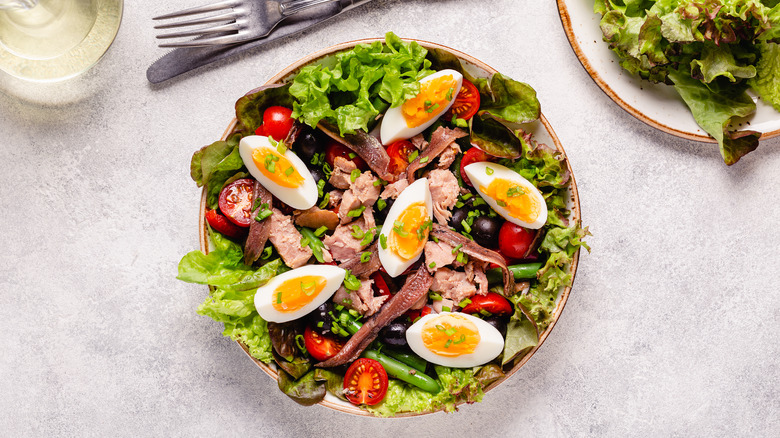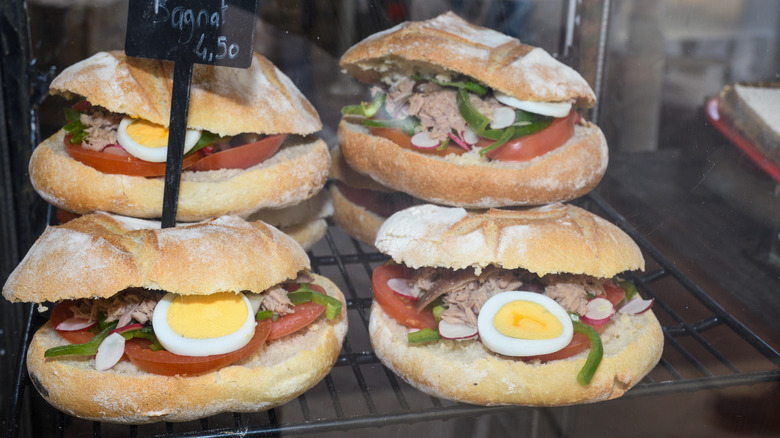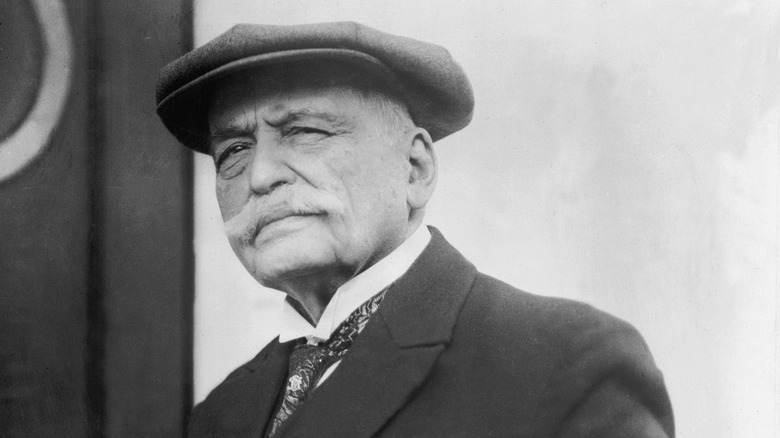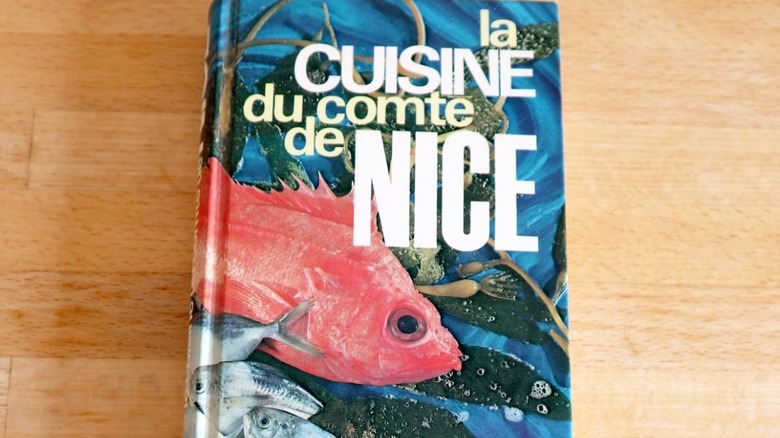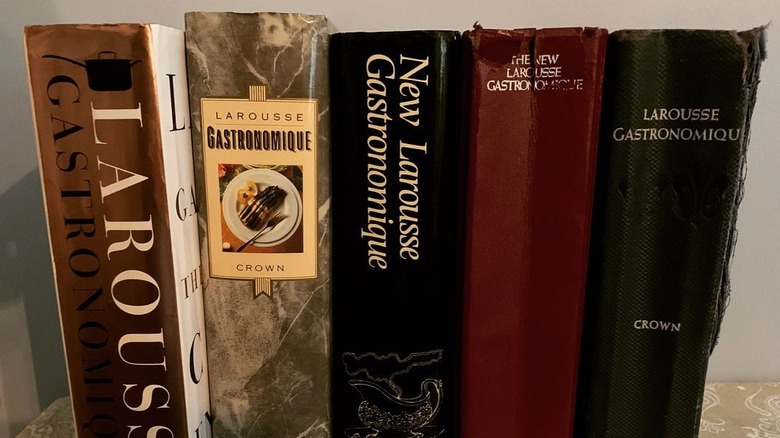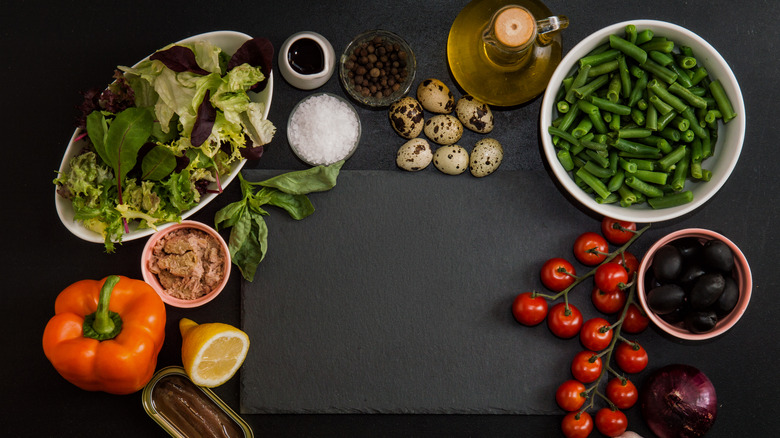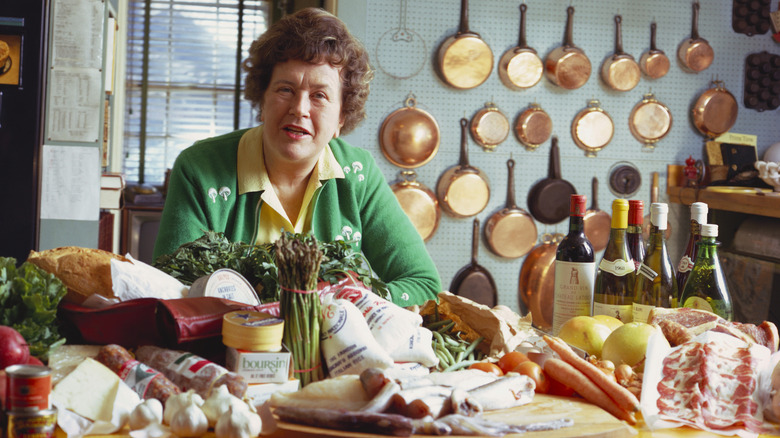The Contentious Origins Of The Niçoise Salad
Nice, a French city situated along the country's Mediterranean coast, is just as renowned for its cuisine as for its views and nice weather. Due to Nice's proximity to Italy, the town itself has a contentious history — Nice didn't officially become French until it was formally ceded to France in 1860. Having gone back and forth between French and Italian control in previous centuries, the city is a cultural cross-section with cuisine that reflects the influence of both countries.
The fusion aspect of Niçoise cuisine is reflected through the Mediterranean produce that comprises many of the city's traditional dishes. This has allowed the place to transcend both French and Italian cuisine to develop a gastronomy that is entirely its own. As the home of iconic dishes like socca and ratatouille, Nice cuisine now has a reputation around the world. However, none of these local recipes have become quite as ubiquitous as the salade Niçoise.
Niçoise salad represents the city's unique cuisine through its versatile ingredients, though a passionate debate has prevailed as to what ingredients are necessary for its most authentic form. The French, at least, agree on one fundamental aspect of the recipe. "The tuna is canned," Michelin-starred French chef Eric Ripert once told The New Yorker. "In France, I have never seen fresh tuna, or seared-on-the-outside tuna, or sushi-grade. Never. You also don't see tuna in brine. It's tuna in a can with olive oil," Ripert added.
The salad started as a sandwich
The Niçoise salad has continuously evolved to incorporate or eliminate certain ingredients, though many believe it wasn't originally a salad at all, but rather started out as an affordable sandwich. Known as pan bagnat – which translates to "bathed bread" in Nissard (the historic French dialect of Nice) — this sandwich was initially composed of tomatoes, anchovies, and olive oil served on stale bread. It was popular amongst Nice's fishermen in the 19th century. The ingredients within the sandwich moistened the bread back to an edible consistency, ensuring nothing from humble Nissard kitchens went to waste.
It is certainly plausible that pan bagnat evolved from a sandwich into a salad. This transformation required only eliminating bread from the equation and adding fresh, seasonal vegetables. Like the salad version, pan bagnat continued to evolve and lives on today. To make it, Niçoise salad ingredients get tossed together and then put between two pieces of bread (or occasionally inside a sliced baguette) for a Mediterranean take on a tuna salad sandwich.
This chaotic French sandwich has since become a common street food and picnic staple in the greater Nice region. However, it remains passionately surveyed for authenticity by La Commune Libre du Pan Bagnat, a local group based in the city which strives to uphold the most traditional pan bagnat recipe.
A famous French chef added different toppings
Considered a definitive voice of French gastronomy, Auguste Escoffier was a French chef who often cooked for royalty but was dedicated to the people. A proponent of simplicity, he championed seasonal ingredients and avoided excessive garnishes. Escoffier is credited with inventing over 5,000 recipes. He famously published the "Guide to Modern Cookery" (known in French as the "Guide Culinaire"). The text, which was first published in 1903, defines classic French dishes, includes French cooking tricks, and sets down the fundamental principles of French cuisine. But despite being a respected authority on French food, Escoffier is accused of committing gastronomic blasphemy when it comes to his recipe for a salade Niçoise.
"Take equal quantities of French beans, potato dice, and quartered tomatoes. Decorate with capers, small, stoned olives, and anchovy fillets. Season with oil and vinegar," Escoffier writes in the "Guide Culinaire," (via Internet Archive). The mention of green beans and potatoes as elements of a true Niçoise salad has enraged Nice's culinary sticklers ever since.
Both potatoes and green beans are in fact grown along the Mediterranean coast, which would fit the Niçoise salad's vague traditional precedent of incorporating local garden produce. But as to where Escoffier got the idea that these vegetables were imperative salad ingredients, the provenance remains unclear. Whether his experimental side was taking creative liberties with a traditional Niçoise recipe or he was simply misinformed, Escoffier's casually authoritative version of the salad certainly underestimated Nice's pride in its traditional fare.
A local politician was adamant about raw vegetables
"La Cuisine du Comte de Nice," published in 1972, was written by the culinary purist and former mayor of Nice, Jacques Medecin. The figure became the authority on his hometown's cuisine by the sheer force of his printed opinions. His assertions in regard to the Niçoise salad are especially autocratic, as he considered misrepresentations of the salad to be borderline criminal.
For his salade Niçoise, Medecin suggested using mostly tomatoes, no vinaigrette, and either tuna or anchovies — but not both. This was because tuna was once considered a special occasion fish in Nice; anchovies were the everyday alternative. But to Medecin, nothing could pose greater sacrilege than the possibility of pulling an Escoffier. A passionate disclaimer precedes his version of the recipe, asserting that anyone wishing to be worthy of Niçoise cookery should never include boiled potato (or any boiled vegetable) in a salade Niçoise.
Medecin was rather a purist in all aspects of his public persona. He even would not let Nice participate in the bicentennial celebration of the French Revolution, since the city had technically still been Italian in 1789 when the revolution occurred. Despite his local popularity, Medecin's authority on all matters came into question when he was charged with allegations of corruption which landed him briefly in prison.
Encyclopedia editions suggest different ingredients
While many in Nice may disagree with Escoffier's take on Niçoise salad, his version with green beans and potatoes has appeared in other publications on the French cuisine. Similar recipes have appeared in "Larousse Gastronomique," a famous culinary encyclopedia that focuses on French food. Though this compilation was initially published in 1938, it has continuously oscillated back and forth on the ingredients essential to a Niçoise salad in later editions.
In an English translation of "Larousse Gastronomique" published in 1961, Escoffier's recipe seems to have made an impact. "Mix equal parts of potatoes and French (string) beans, both cut in dice," the recipe begins, according to Internet Archive. But, calling for anchovies alone, the recipe makes no mention of tuna.
By the time the 1988 edition of the encyclopedia came out, the salad recipe had significantly altered, eliminating potatoes and other cooked vegetables from the ingredients list and requesting both tuna or anchovies among the toppings, per Internet Archive. It's possible Jacques Medecin's passionate salad stance in his zealous Niçoise cookbook — published in 1972, between editions of the encyclopedia — may have had some influence on the Nissard cuisine. But even the "Larousse Gastronomique" does not follow Medecin's recipe exactly. The shifting nature of what makes a Niçoise salad suggests that the recipe may be more fluid than purists would prefer.
A Nice-based organization polices Niçoise salad
Despite the many changing recipes for Niçoise salad, there are still groups that emphasize its authenticity. An organization called The Cercle de la Capelina d'Or has served as Nice's culinary police force, developing the label of "Cuisine Nissarde" in 1995. The label is reserved for dishes that they believe preserve Nice's culinary history, to ensure true Nice restaurants serve authentic local fare. Renee Graglia, the group's former president, had clear assertions for a true salade Niçoise.
"We have thoroughly consulted many cookbooks and dug up the most representative recipes," Graglia said in an interview with Times of Malta. The Cercle's Niçoise salad recipe allows for beans, raw artichokes, and green peppers for the vegetable component. Otherwise, the salad should consist only of tomatoes, hard-boiled eggs, anchovies, tuna, spring onions, black olives, and basil. It is seasoned with nothing more than olive oil and salt. Only a few drops of vinegar are permitted. As a "composed salad," the Niçoise salad is arranged on a plate — the ingredients are not tossed together.
Despite strong Nissard convictions against them, boiled green beans and potatoes are regularly served as part of Niçoise salads, especially outside of Nice. In the case of this particular salad, the popular might overpower the orthodox.
Julia Child slightly Americanized the recipe
The salade Niçoise gained popularity on the other side of the Atlantic with the publication of American celebrity chef and culinary icon Julia Child's cookbook, "Mastering the Art of French Cooking." First published in 1961, this culinary guide debunked the mystique of French cuisine with encouraging techniques anyone could perfect. Child's version of Niçoise salad, however, defies the principles of cuisine Nissarde, including some disgraced ingredients and leaving out other essentials. Child's recipe, described as a "Mediterranean Combination Salad" (via Internet Archive) calls for simply tuna, anchovies, tomatoes, potatoes, green beans, hard-boiled eggs, and lettuce. It is to be dressed with a vinaigrette, which goes against some of the more traditional recipes.
Child's cookbook also includes directions on the method of assembly. "Green vegetables will lose their fresh color if they sit in vinaigrette for more than half an hour," the book warns. Although Child does recommend tossing some lettuce in the vinaigrette, her directions are mostly consistent with instructions for a typical composted salad.
Some American substitutes for the Niçoise salad have overturned most of the defining ingredients, with variations replacing boiled potatoes (a controversial ingredient already) with mashed potatoes, opting for chicken instead of tuna, using mayonnaise in lieu of vinaigrette, or avoiding anchovies altogether. These alterations reflect a difference between American and Nissard palates, further emphasizing that the salade Niçoise is truly and unabashedly French in its purest form.
